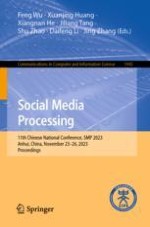2024 | Buch
Social Media Processing
11th Chinese National Conference, SMP 2023, Anhui, China, November 23–26, 2023, Proceedings
herausgegeben von: Feng Wu, Xuanjing Huang, Xiangnan He, Jiliang Tang, Shu Zhao, Daifeng Li, Jing Zhang
Verlag: Springer Nature Singapore
Buchreihe : Communications in Computer and Information Science
